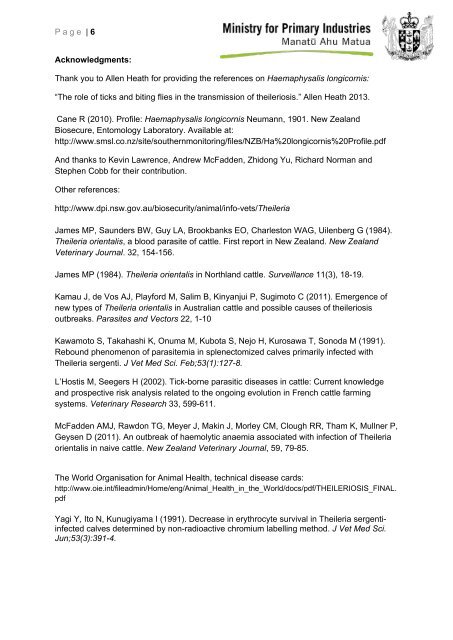Page | 1 Questions and Answers Surrounding the 2012-2013 ...
Page | 1 Questions and Answers Surrounding the 2012-2013 ...
Page | 1 Questions and Answers Surrounding the 2012-2013 ...
You also want an ePaper? Increase the reach of your titles
YUMPU automatically turns print PDFs into web optimized ePapers that Google loves.
<strong>Page</strong> | 6<br />
Acknowledgments:<br />
Thank you to Allen Heath for providing <strong>the</strong> references on Haemaphysalis longicornis:<br />
“The role of ticks <strong>and</strong> biting flies in <strong>the</strong> transmission of <strong>the</strong>ileriosis.” Allen Heath <strong>2013</strong>.<br />
Cane R (2010). Profile: Haemaphysalis longicornis Neumann, 1901. New Zeal<strong>and</strong><br />
Biosecure, Entomology Laboratory. Available at:<br />
http://www.smsl.co.nz/site/sou<strong>the</strong>rnmonitoring/files/NZB/Ha%20longicornis%20Profile.pdf<br />
And thanks to Kevin Lawrence, Andrew McFadden, Zhidong Yu, Richard Norman <strong>and</strong><br />
Stephen Cobb for <strong>the</strong>ir contribution.<br />
O<strong>the</strong>r references:<br />
http://www.dpi.nsw.gov.au/biosecurity/animal/info-vets/Theileria<br />
James MP, Saunders BW, Guy LA, Brookbanks EO, Charleston WAG, Uilenberg G (1984).<br />
Theileria orientalis, a blood parasite of cattle. First report in New Zeal<strong>and</strong>. New Zeal<strong>and</strong><br />
Veterinary Journal. 32, 154-156.<br />
James MP (1984). Theileria orientalis in Northl<strong>and</strong> cattle. Surveillance 11(3), 18-19.<br />
Kamau J, de Vos AJ, Playford M, Salim B, Kinyanjui P, Sugimoto C (2011). Emergence of<br />
new types of Theileria orientalis in Australian cattle <strong>and</strong> possible causes of <strong>the</strong>ileriosis<br />
outbreaks. Parasites <strong>and</strong> Vectors 22, 1-10<br />
Kawamoto S, Takahashi K, Onuma M, Kubota S, Nejo H, Kurosawa T, Sonoda M (1991).<br />
Rebound phenomenon of parasitemia in splenectomized calves primarily infected with<br />
Theileria sergenti. J Vet Med Sci. Feb;53(1):127-8.<br />
L’Hostis M, Seegers H (2002). Tick-borne parasitic diseases in cattle: Current knowledge<br />
<strong>and</strong> prospective risk analysis related to <strong>the</strong> ongoing evolution in French cattle farming<br />
systems. Veterinary Research 33, 599-611.<br />
McFadden AMJ, Rawdon TG, Meyer J, Makin J, Morley CM, Clough RR, Tham K, Mullner P,<br />
Geysen D (2011). An outbreak of haemolytic anaemia associated with infection of Theileria<br />
orientalis in naive cattle. New Zeal<strong>and</strong> Veterinary Journal, 59, 79-85.<br />
The World Organisation for Animal Health, technical disease cards:<br />
http://www.oie.int/fileadmin/Home/eng/Animal_Health_in_<strong>the</strong>_World/docs/pdf/THEILERIOSIS_FINAL.<br />
pdf<br />
Yagi Y, Ito N, Kunugiyama I (1991). Decrease in erythrocyte survival in Theileria sergentiinfected<br />
calves determined by non-radioactive chromium labelling method. J Vet Med Sci.<br />
Jun;53(3):391-4.
















